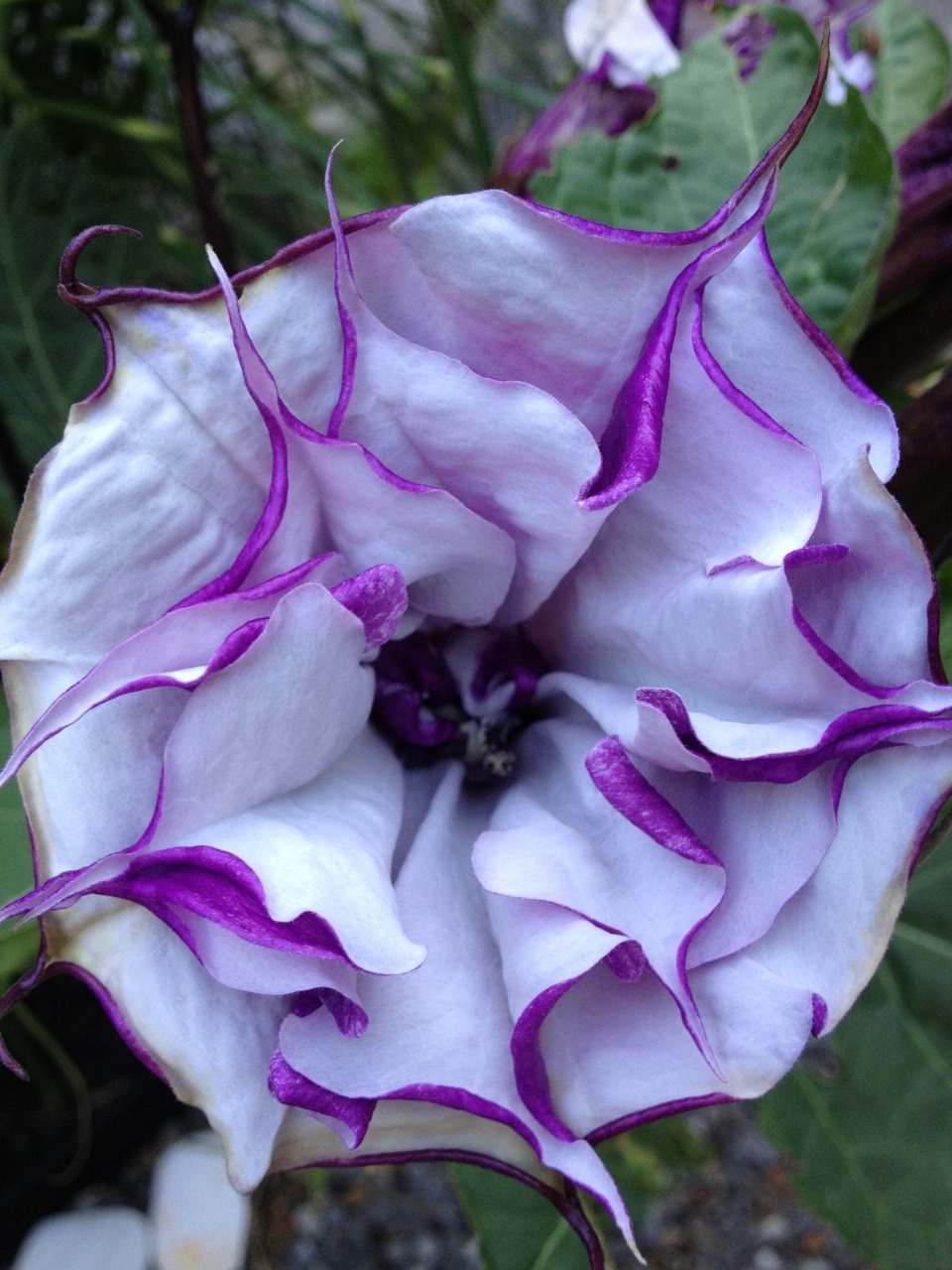The Datura metel, also known as Devil’s Trumpet, is an ornamental plant that’s admired for its striking beauty. With its large, trumpet-shaped flowers that feature a fascinating purple and white gradient, it has captured the attention of gardeners worldwide. Despite its beauty, this plant is notorious for being highly toxic if ingested. While it’s great for ornamental purposes, caution is essential when handling this plant.
Characteristics of Datura metel (Devil’s Trumpet)
- Flower Appearance: The flowers of Datura metel are among the most visually striking of any plant. They bloom in large, trumpet-shaped formations, with the petals curling outward in a spiral pattern. This dramatic shape and the vibrant color combination of purple and white make it a showstopper in any garden.
- Fragrance: The flowers release a mild fragrance, most noticeable during the evening. The scent can add a delicate, almost ethereal quality to your garden, especially in the cool, calm hours of the night.
- Toxicity: The entire plant, including its leaves, stems, seeds, and flowers, is toxic. It contains powerful alkaloids such as scopolamine, hyoscyamine, and atropine, which can be harmful to both humans and animals. Ingestion of any part of the plant can lead to serious poisoning, resulting in symptoms like confusion, dilated pupils, dry mouth, and in severe cases, death.
Ideal Growing Conditions
- Climate: Datura metel is a tropical to subtropical plant that thrives in warm climates. The ideal temperature range for this plant is between 20°C to 30°C (68°F to 86°F). It grows best in humid environments, which is why it’s particularly suited for regions that experience warm summers.
- Light: This plant requires full sun for optimal growth. Make sure to place it in a location where it can receive direct sunlight for most of the day. Lack of sunlight may affect the quality of the blooms and overall plant health.
- Soil: Datura metel prefers well-draining soil. A loamy or sandy soil mix works best as it allows for good drainage. While the plant can tolerate various types of soil, ensuring proper drainage is essential to avoid root rot.
Care Tips for Datura metel
- Watering: Although Datura metel can withstand short periods of drought once established, it still requires consistent watering, especially during dry spells. Ensure that the soil stays moist, but be careful not to water too much, as it can lead to waterlogging. Allow the top layer of soil to dry out before watering again.
- Fertilizing: This plant benefits from fertilization during the growing season. Apply a balanced fertilizer every few weeks during the spring and summer months. Be sure to follow the manufacturer’s instructions to avoid over-fertilization, which can harm the plant.
- Pruning: Regularly prune dead or spent flowers to keep the plant looking neat and encourage the growth of new blooms. Datura metel can also be pruned in late winter to maintain its shape and size, as it tends to grow rather large. Be sure to handle it with care, especially considering its toxic nature.
Safety Considerations
While Datura metel is a beautiful addition to any garden, it’s important to remember that it is highly toxic. All parts of the plant contain potent chemicals that can cause severe symptoms if ingested. Keep this plant out of reach of children, pets, and livestock, as even small amounts of ingestion can lead to poisoning. Always handle it with gloves, and wash your hands thoroughly afterward.
If you suspect someone has ingested part of the plant, seek medical attention immediately. Symptoms of poisoning can include dry mouth, blurred vision, hallucinations, confusion, and in severe cases, it may cause heart issues and death.
How to Grow Datura metel
- Planting: Datura metel can be grown from seeds or young plants. When planting seeds, start them indoors in seed trays about 6-8 weeks before the last frost date. Sow the seeds in a well-draining seed-starting mix and keep them in a warm environment. Once the seedlings are strong enough and the weather warms up, they can be transplanted into your garden.
- Maintenance: Datura metel does not require heavy maintenance but does need adequate space to spread out. These plants can grow quite large and may need staking or support to ensure their stems remain upright as they grow taller.
- Winter Care: In colder climates, Datura metel may not survive the winter. If you live in an area where temperatures drop below freezing, it’s best to treat it as an annual or bring it indoors during the colder months. Alternatively, you can overwinter the plant by cutting it back and storing it in a cool, dry place until the next growing season.
Conclusion
The Datura metel or Devil’s Trumpet is a plant that stands out due to its beauty and fragrance, making it an attractive choice for gardeners looking for something unique. However, it’s important to treat this plant with respect and caution because of its toxic nature. While it thrives in warm climates and full sun, it is essential to keep it out of reach of children and pets. With proper care, it can be a stunning addition to your garden, offering a dramatic contrast with its purple-white flowers and fragrance that blooms in the summer.
Remember, while this plant is beautiful, it’s important to handle it responsibly and safely. If you are looking to add a unique ornamental plant to your garden, consider the Datura metel for its vivid blooms, but always keep its toxic properties in mind for the safety of everyone around.
